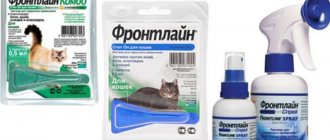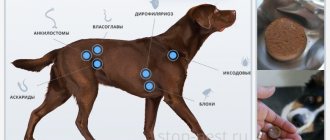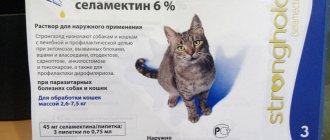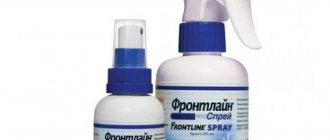Skin parasites of cats
The most common and common in cats are:
- Fleas choose not only animals as victims, but also humans. Insects actively jump on the animal's skin and are easy to notice. More than 60 species of blood-sucking parasites carry over 200 diseases: anthrax, typhoid fever, salmonellosis, helminthiasis, and various fungal infections. Adult fleas do not live on the victim's body 24 hours a day. Having had enough, they leave the cat.
- Lice eaters are small wingless insects. They feed on particles of fur and epidermis, and blood. Like other ectoparasites, lice eaters force the cat to constantly scratch the skin until wounds appear. Damaged skin is easily attacked by pathogenic bacteria. When a cat is infected with a lice-eater, sleep and appetite are disrupted, immunity decreases, and allergies occur.
- Lice - when infested with lice, the animal behaves restlessly, scratches the skin, and loses hair. Lice are easy to spot. On your pet's light coat, black dots that look like dirt and dust are clearly visible - these are parasite excrement. In case of mass infection, the animal faces dermatitis and complete baldness. Lice are carried by helminth larvae.
- Ixodid ticks - attack cats in the warm season. These small insects feed on blood and grow greatly in size. A swollen tick can be noticed immediately. A cat's skin and fur are very sensitive, so the animal can easily shake off an unattached tick from its skin. In search of food, insects willingly move onto people. Ticks carry many diseases: viral encephalitis, typhus, tularemia, hemorrhagic fever, piroplasmosis, helminthiasis, etc.
- Scabies mites live on the skin of a cat, gnawing passages in the inner layer of the dermis. They feed on epithelial cells and lymph. From a sick animal the tick is transmitted to people.
- Sarcoptoid mites are the cause of scabies. The peculiarity of this form is the rapid baldness of the ears, belly and muzzle.
- Ear mites - attack the animal's hearing system. The cat shakes its head and tries to get its hind paw inside the ear. Dark brown crusts form in the ears, followed by pus. Without treatment, the parasites gradually penetrate through the inner ear into the brain, and the animal dies.
- Heartworms (dirofilaria) cause one of the most dangerous diseases, dirofilariasis. The helminth larvae enter the mouthparts of the mosquito with the blood of the infected creature, and with the next bite the parasites enter the body of the final victim. They live under the skin, in the muscles of internal organs. Parasites destroy the heart, lungs, and coronary vessels. Without treatment, the animal faces death.
Photo gallery: dangerous cat ectoparasites
Fleas are the most common skin parasites
Hairworm - the cause of focal baldness in cats
Cat lice are as common as fleas, although they are less well known.
Hungry and well-fed ticks are very different in appearance
Getting rid of ear mites is a long and expensive task.
Heartworm is the causative agent of dirofilariasis, spread by mosquitoes.
Answers to popular questions
Many cat owners are interested in questions related to the nuances of using Frontline
Since the cat is a member of the family, and the health of the pet is under the close attention of the owners, they are looking for answers to their questions related to the treatment of the cat’s skin and further actions
Is it possible to scratch after treatment?
After treatment, touching the cat is not allowed. The procedure must be carried out with rubber gloves to prevent contact of the substance with your hands. The drug is applied to the clean skin of the cat, from where, due to its accumulative properties, it is gradually absorbed into the sebaceous glands, mixed with skin secretions and acts on parasites, causing their death. If you scratch your cat after applying the drug, microcracks may form, through which the product will enter the bloodstream and cause a negative reaction.
Can it be used on a dog?
It is perfectly acceptable to use Frontline on a dog. The manufacturer produces a separate type of drug in the form of a spray and drops, intended for treating dogs. The amount of medication used depends on the dog's weight.
Is it possible to divide by less?
When separating the contents of the pipette, there is a risk of violating the dosage of the active component and the alcohol-containing element, which will lead to the ineffectiveness of the medicine.
Is it okay for pregnant cats?
The drug Frontline has been tested in clinical conditions and is considered an absolutely safe treatment for cats during pregnancy.
Is it possible to put drops in the ear?
You can put Frontline drops into your ear if you are infected with ear mites. The procedure must be performed by a veterinarian in a clinic setting. The ears must be clean so that no dirt remains deep in the ear.
To treat ear mites, a spray is also used, which is sprayed into the auricle after preliminary cleaning.
Is it possible to pet a cat?
Touching a treated cat is prohibited, especially for children and people prone to allergies. The cat should not be petted until the area where the drug is applied is completely dry (about 24 hours). It is not allowed to take a treated animal into bed.
Is it possible to wash a cat?
Bathing with (or without) shampoo 1 hour before treatment does not affect the effectiveness of the drug, provided that the pet’s fur and skin are completely dry. Washing or bathing the cat is allowed 48 hours after treatment.
Composition and release form of the drug Frontline
To combat skin parasites of cats, the French corporation Merial SAS created the drug Frontline. The company conducts serious research and has a strong reputation in the market for manufacturers of veterinary drugs.
The drug is available in three dosage forms:
- drops in polyethylene pipette bottles with a volume of 0.5 to 4.02 ml;
- spray in bottles with a sprayer of 100, 250 and 500 ml;
- Chewable tablets (for dogs only)
Table: dosage forms for cats
| Name | Dosage form | Volume, ml | Included | |
| active substance | Excipients | |||
| Frontline Spot On | drops on the withers |
| fipronil |
|
| Frontline Combo | drops on the withers |
|
|
|
| Frontline Spray | spray |
| fipronil |
|
Photo gallery: release forms
Frontline spray with a volume of 100 and 250 ml is most convenient for home use
Drops for the withers Frontline Spot It are available in a dropper bottle with detailed instructions
Frontline combo acts not only on adult parasites, but also on their eggs and larvae
Frontline Nexgard meat-flavored chewable tablets are for use only in dogs.
Active ingredients of the veterinary drug Frontline:
- Fipronil has a detrimental effect on the central nervous system of parasites, disrupting the movement of nerve impulses. Causes paralysis and subsequent death of insects. Fipronil does not have a systemic effect on the body of a pet, destroying only pests.
- S-methoprene (as part of Frontline Combo) is an analogue of the hormone-regulator of insect growth, causes developmental anomalies at the egg and larval stages, prevents the appearance of adult individuals on animals and in places where they are kept.
Additionally, Frontline contains excipients:
- in the spray - isopropanol, copolyvidone, purified water, polysorbate;
- in drops on the withers - butylated hydroxyanisole, butylhydrotoluene, diethylene glycol, polyvidone, polysorbate.
The content of the active substance in any form ensures effective destruction of parasites.
Frontline Nexgard chewable tablets for dogs
There are situations when it is very inconvenient or even contraindicated to use external means to combat the parasite. For example, there are wounds on the dog’s skin or you bathe him often and therefore the drops are not effective. Frontline Nexgard chewable tablets will come to your aid.
You will immediately cope with two tasks: firstly, get rid of external parasites; Secondly, the tablets act on worms inside the animal.
Nexgard chewable tablets for fleas, ticks and worms contain the active ingredient afoxolaner. The medicine tastes like beef stew, so dogs eat it with pleasure.
The effect of the medication begins within half an hour after administration. Complete destruction of parasites occurs within 6-48 hours.
It is very convenient that you only need to use the tablets once a month.
Instructions for use
The manufacturer took care not to calculate the dosage of the drug. You just need to weigh your pet and buy the necessary box. There are 4 types of tablets, depending on the weight of the animal: from 2 to 50 kg. Per 1 kg of animal weight, 2.5 mg of afoxolaner is required.
Give the medication separately or with food. Do not break the tablets or they will no longer be effective. The medicine is contraindicated in dogs weighing up to 2 kg or under 2 months of age. Give medication to pregnant and lactating females only with the consent of the veterinarian.
Frontline is an effective insect repellent for dogs. When choosing a form of medication, rely not only on ease of use, but also on existing contraindications, the age of the animal and the degree of infection.
There is also a separate form of Frontline for cats.
Mechanism of action
After use, the active substance does not penetrate into the blood, but is distributed throughout the skin and hair. The drug has a contact effect - parasites die when they come into contact with Frontline microparticles. After the product gets on the skin, the active agents fipronil and S-methoprene, together with sebum, are distributed over the surface, enveloping the hairs and covering every millimeter of the cat’s body with an invisible veil.
Frontline acts contactally, destroying only parasites
Owner reviews
Bonnie-Blue: “Frontline drops were recommended to me by both the vets and a volunteer friend who helps homeless animals. I treated my cat with them for several years and was satisfied. But last year I also got a dachshund. The drops don't help her at all. Moreover, allergies popped up. I took the drug at the clinic, so counterfeits are excluded.”
CHOYU: “My two dogs spend the summer at the dacha, where there is a sea of ticks. I give them Spectra and no problems: insects only allow themselves to crawl on animals.”
Katushka: “We came out of town for the weekend. While combing, I discovered fleas on my Spitz dogs. The choice of medication has become a problem because... I had a recently whelped female with two-week-old kittens. I decided that it was better to use Frontline Spray. It smells unpleasant, but the fleas disappeared on the third day. And all the pets, including babies, underwent the procedure without any problems.”
How to use Frontline correctly - treatment algorithm
Before treatment, it is recommended to weigh the cat, determine the required dose, comb the cat’s fur, and remove all tangles. The pet's skin must be completely dry, undamaged, without open wounds or visible scratches at the site of application. For cats, the drug Frontline is used in 0.5 ml applicators.
The procedure for treating a cat with drops on the withers at home:
- Wear protective gloves.
- Remove the dropper bottle from the packaging, move the drug into the wide part of the bottle using tapping movements, and unscrew the tip of the dropper.
- Spread the fur at the withers, exposing the skin at the junction of the cervical spine and the thoracic spine (on the shoulder blades).
- Squeeze the pipette and apply a few drops of the solution in a heap, in a checkerboard pattern.
- Distribute the preparation over the skin, running your hand several times against and along the growth of the fur.
Video: how to treat a cat for fleas using drops
Remember! Drops are applied pointwise in a checkerboard pattern to the area between the shoulder blades (at the withers).
To get rid of ear mites, 4-6 drops are injected into each ear canal. To distribute the drug evenly, the ear is closed and easily kneaded. The remaining drops in the pipette bottle can be applied to the withers.
Remember! For 2 days after treatment, protect the cat’s fur from moisture, do not bathe or use other drugs against skin parasites.
The procedure for self-treating a cat with Frontline spray:
- Processing should be done outdoors or in a well-ventilated area.
- Wear protective gloves and respiratory protection.
- Fasten the pet's protective neck collar and secure its jaws until the preparation dries completely on the fur.
- Fluff the cat's fur against the natural hair growth.
- Shake the bottle thoroughly.
- Holding the spray can upward at a distance of 10–20 cm from the cat, press the head of the aerosol can.
- Treat your pet until the fur is moistened, starting from the tail: back, belly, limbs.
- To treat the face, groin and armpits, apply the product to the glove and rub into the fur, avoiding contact with the eyes and mucous membranes.
- Brush the fur with a wide-toothed brush to get the product onto the skin.
The drug consumption is 3 ml per 1 kg of weight for short-haired cats and 6 ml for long-haired cats. The product is convenient to dose: one press removes a 0.5 ml dose of Frontline from a 100 ml bottle.
Typically required for cats weighing:
- up to 5 kg - from 30 for short-haired to 60 clicks for long-haired animals;
- up to 10 kg - from 60 to 120 presses;
- up to 15 kg - from 90 to 180 presses.
A single treatment of a cat with Frontline kills parasites in 1–2 days. Barrier protection against ticks lasts for 4 weeks, against fleas, lice and lice for 6 weeks.
Video: how to treat your pet for skin parasites using a spray
Remember! Treat all animals in the house, change bedding or disinfect them, otherwise re-infection is possible.
I recently got a new cat. A foundling, like all my animals. The poor guy jumped out onto the road opposite the dacha cooperative. It was at the end of autumn, with the onset of the first cold weather. The unfortunate animal was on the verge of death. I took him home. The cat was so scared and exhausted that I decided to give him time to recover from the stress. He went to the vet 3 days later. Upon examination, all possible parasites were discovered: worms, fleas and ear mites. The cat was prescribed treatment. The doctor advised to wait 5 days and treat for fleas and helminths. While the waiting period was passing, the other cat also began to itch, although the animals had almost no contact. During the second visit, the veterinarian recommended treating the cat with Frontline Combo anti-flea drops on the withers once, and treating the cat with Frontline Spot On drops twice according to the scheme. And he focused on replacing or disinfecting bed mats. I didn’t even think about changing the bedding! There was no need to wear any collars, and there was no aggressive smell; both pets tolerated the procedure well. An easy and simple solution, and the fleas were defeated. I noted for myself the importance of regular flea treatment. Parasite eggs can be brought in from the street on the soles of shoes. And then the infection will occur again.
Recommendations
There is no need to bathe the animal 2 days before and 2 days after treatment. Until the fur is completely dry, you need to make sure that the animal does not lick the drug. Also, do not allow it near heating devices or open fire. Young children should be excluded from contact with the animal for 24 hours. During this time you cannot pet him. To avoid re-infestation and prevent fleas from breeding, the bedding should be replaced. In addition, the following rules must be observed:
- after applying the spray, you should wash your hands with soap;
- when applying the product, do not eat, drink or smoke;
- the drug should be stored out of the reach of children.
High effectiveness of the drug is achieved by following the recommended regimen of its use. When using the product, you should not use other insectoacaricidal drugs.
Indications for use
Frontline is prescribed to cats:
- for the treatment and prevention of diseases caused by fleas, lice and lice, ixodid ticks;
- complex therapy of allergic dermatitis caused by fleas;
- to prevent the attachment and development of ectoparasites on animals.
Frontline Spot It repels mosquitoes and destroys:
- mature fleas;
- lice eaters;
- ixodid ticks (all phases of development);
- lice;
- scabies mites.
Frontline Combo also repels mosquitoes and destroys:
- fleas (mature and insects in the egg, larvae, and pupal stages);
- lice eaters;
- ixodid ticks (all phases of development);
- sarcoptoid mites.
Frontline Spray is used to destroy:
- mature fleas;
- lice eaters;
- ixodid ticks (all phases of development);
- lice.
Use of the product for kittens and pregnant cats
The drug does not have a toxic effect on the fetus and the growth of cubs, therefore it is successfully used in the treatment of kittens, pregnant and lactating cats.
Frontline protects both small kittens and nursing cats equally effectively
When treating a lactating cat, Frontline Spot On drops are better suited. Then there is no need to isolate the cubs or wait for the moisture to evaporate from the mother’s hair. Kittens over two days old can be treated with a spray. However, for such babies, the manual method of extermination will be simple and safe. In the delicate fur, tiny pests can be easily caught.
Precautionary measures
As mentioned above, the medication is one of the drugs that is low-risk for the body of dogs.
Complies with GOST standard 12.1.007.76 However, when working with Frontline, as with any medicine, precautions should be taken:
Strictly observe the dosage of the drug. Do not use in conjunction with an anti-parasitic collar. Observe age restrictions on the use of the product. Use with caution on weakened and older dogs. Use with caution for pregnant and lactating individuals. If possible, during these periods, avoid any chemical exposure without special indications. Be sure to check with your veterinarian about possible interactions between fipronil and other medications. Before use, you should make sure that the dog does not have an individual intolerance to the components of Frontline.
Contraindications and side effects from the drug Frontline
The product is not used:
- with hypersensitivity to the components of the drug;
- for infectious diseases;
- with decreased immunity after a recent illness;
- in the process of treating otodectosis (ear mites) when the integrity of the eardrum is damaged;
- in case of possible contact of the drug with the mucous membrane of the eyes, on wet or damaged skin.
When used according to the treatment regimen, the drug does not have any side effects. If the dose of a veterinary drug is exceeded, the animal may experience:
- salivation;
- vomit;
- rapid breathing.
If symptoms of overdose are pronounced, the cat should be shown to a veterinarian, the animal should be washed with hypoallergenic pet shampoo, and antihistamine therapy should be administered.
Remember! Strictly adhere to the regimen of using the drug, otherwise the effectiveness of killing parasites will decrease.
conclusions
The drugs are generally good products that will destroy the parasites that have already settled on your pet and prevent subsequent infestations. The only thing is that it is better not to take Spectra, but to independently select an anthelmintic with a wider spectrum of action: Canikquantel, Drontal, Profender, Milbemax, Alben S, etc.
For several years I prescribed Frontline without fear. But lately there are a few things to consider:
- counterfeits have become more frequent;
- the clinic is often contacted about negative reactions after using drugs;
- Entomoses and acaroses are becoming increasingly common in animals treated with drugs from Merial.
It is also impossible to ignore the observations of breeders who note mutagenic effects in litters of healthy purebred dogs and even mongrels, in which the risk of recessive genes and associated hereditary diseases is minimal. Although no research has been done on this, keep this point in mind.
Frontline drops, spray and tablets are controversial drugs. In most cases, they work well and do not affect the dogs' health. But it may cause side effects or may not work in some animals. Therefore, there is a reason to choose another medication: Bravecto, Bars, Hartz, Rexolin.
Interesting read: What kind of dog to have in an apartment
Approximate cost and existing analogues
In online stores the drug can be purchased at a price of 880 rubles. for a 100 ml spray bottle, Frontline Spot On drops - 460 rubles, Frontline Combo drops - 520 rubles. per dropper bottle.
Table: analogues of the drug Frontline
| Drug name | Release form | Country of Origin | What parasites does it protect against? | Active substance | Price, rub | Compared to the drug Frontline Spot On drops on the withers | |
| dignity | flaws | ||||||
| Stronghold | drops | USA |
| selamectin | 800 |
|
|
| Blokhnet |
| Russia |
| fipronil | 100 | significantly lower price | minimum drop volume 1 ml. |
| Fiprist |
| Slovenia |
| fipronil | 300 |
| shorter duration of action. |
| Leopard |
| Russia |
| fipronil | 70 |
| Contraindicated for pregnant and lactating cats. |
| Rolf | drops | Russia |
| fipronil; pyriproxyfen. | 200 | lower price |
|
| Advantage | drops | Germany |
| imidacloprid | 250 |
| less protection (not effective against ticks). |
FAQ
Can it be used by animals during pregnancy or lactation?
According to the results of numerous international tests, experts have not identified any negative effects on this category of pets. Frontline is the only insecticidal and acaricidal drug whose use is permitted during these periods. In order to treat kittens under 2 months old, the company produces it in the form of a spray.
Is it dangerous if a pet licks its fur after treatment with Frontline?
No. The drug is not dangerous to life and will not cause harm to the body, however, if it gets inside the body, it can cause excessive salivation, so to avoid this situation, you need to apply the product to those places where the cat cannot lick it off.
Experts advise using the drug to treat cats every 2 months, during periods of danger of infection. If there is a danger of ticks, then the procedure must be repeated every month no more than once.
Does Frontline repel or prevent tick bites?
No. The medicine does not affect the bite. It prevents the transmission of diseases from ticks to pets. The fact is that a tick needs from 48 to 72 hours to infect an animal - this is the time for transmission of infection. During this time, Frontline neutralizes the impact of the tick on the body.
The cat got wet or dirty after using the product, can it be washed?
Yes. The medicine is resistant to an aqueous environment, however, it should be left for 48 hours until the drug is absorbed into the skin. If the pet is washed more than 2 times a month, then treatment should be carried out more often.
Is there a need to take funds in parallel with Frontline?
A medicinal insectoacaricidal preparation in the form of a solution for external use, containing fipronil - 9.8% and S-methoprene - 8.8% as active ingredients, and polyvidone and polysorbate as excipients.
Indications for use
Used to combat fleas, lice, lice and ticks (ixodidae, cheylitella) of cats by topical (Spot On) application to the skin.
Dosage and method of administration
Frontline Combo is used to combat fleas, lice, lice and ticks (ixodidae, cheylitella) in cats by topical (Spot On) application to the skin. Before treatment, break off the tip of the pipette, spread the animal’s fur in the back area (between the shoulder blades) and, pressing the pipette, apply the drug to the skin at one or several points. The protective effect of the drug against ixodid ticks in cats lasts up to 3 weeks, against the imago and preimaginal phases of insect development up to 6 weeks. If the animal is severely affected by lice, fleas, lice, it is recommended to treat once a month. If the animal is washed more than 2 times per month, it is recommended to reduce the interval between treatments to 3 weeks. It is not recommended to wash animals within 48 hours after treatment with Frontline Combo, or to use other insectoacaricidal agents.
Side effects
In terms of the degree of impact on the body, Frontline Combo is a low-hazard substance (hazard class 4 according to GOST 12.1.007.76), in recommended doses, it does not have a skin-resorptive, sensitizing, embryotoxic, teratogenic or mutagenic effect. In case of contact with eyes, it causes mild irritation.
Contraindications
Increased individual sensitivity to the components of the drug. Sick and convalescent animals, as well as kittens under 8 weeks of age, cannot be treated.
Storage conditions
Frontline must be kept in its original, undamaged packaging. Cat food and human food should not be stored nearby. Temperature range – from 0 to 25 degrees. It is necessary to provide protection from direct sunlight, heating devices or open fire. Strictly ensure that children do not have access to the place where the product is located. If the conditions are correctly met, then Frontline Spray is suitable for 2 years from the date printed on the packaging. Frontline Combo and Spot It are valid for 3 years. If the allotted period expires, use is prohibited and the product is thrown away.
Frontline drops for cats
Visit the profile section of our Medical Examination forum or leave your feedback in the comments below. More opinions means more useful information, it will be useful to someone. If there are good and interesting videos on the topic of the article, write and I will insert them into this publication.
Is it worth paying more?
With all the hype and popularity of the drug, one should not forget what made it so powerful. Yes, yes, it's all about the active substance. In the drug "Frontline" it is fipronil, obtained quite recently. The essence of its action is that it affects the GABA channels of insects, interfering with the passage of chlorine ions. As a result, the pest's nervous system collapses and it dies. At the same time, it does not harm the mammal. According to official data and reviews, Frontline can cost from four hundred to one and a half thousand rubles, depending on the characteristics. But the prices for other drugs with the active ingredient fipronil are much more affordable: from one hundred rubles.
Advantages
The benefits of the product include:
- Convenient packaging. Thanks to the pipette, it is easy to apply; the liquid does not get on human skin and does not leave marks on it. This type of packaging helps to accurately calculate the dosage of the medicine.
- Efficiency. The drug destroys all types of insects, even those that have managed to lay larvae on the skin of a pet.
- There are no age restrictions. The Frontline line of antiparasitic drugs includes 3 types of medicinal products with different compositions and specific purposes. Frontline spray can be used by kittens from two days of age.
- Fast action. The medicine kills parasites within 24 hours.
The main advantage of the drug is the prevention of repeated episodes of insects.











